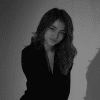How to Hire a Remote Dedicated Development Team: A Step-by-Step Guide
- Updated: Aug 27, 2024
- 13 min
Are you a startup founder, CTO, or head of product looking to hire a remote development team? Keep reading if you answered yes.
In this guide, we’ll cover:
- What is a dedicated remote software team
- Why you should hire a remote team
- Examples of startups using remote teams
- Ways to manage an offshore team
- How to manage remote partners
- Challenges when hiring offshore teams
- And more
Want to build a productive remote team? This guide on high-performance remote teams shows you how.
If you prefer visuals, check out the bonus infographic.
Let’s get started!
Transform your ideas into reality with our dedicated development team — contact us today to get started!
What is a Remote Dedicated Development Team?
A remote dedicated development team is a group of software developers that work remotely and are outsourced by a vendor to a startup with the aim of developing, managing, and launching software.
As opposed to in-house developers that are solely employees of the startup, the dedicated development team is tasked with developing and managing a product for a scheduled time.
Once the dedicated team has achieved their goals, they’re detached from such startups and focus on another.
Here’s a concise checklist of characteristics of a remote dedicated development team.
- The team works remotely;
- They’re not on the startup’s payroll;
- The startup did not recruit them;
- They only owe their loyalty to the project and not the startup;
- They stop interacting with the startup once their contract expires.
Once it aligns with the above checklist, then it’s a remote dedicated team.
Want to build a strong founding team? Start by learning how to find a technical co-founder. 
Let’s delve into the pros of hiring this team type.
Why Hire a Remote Dedicated Software Development Team?
Hiring a remote dedicated software development team offers you a range of benefits that include: cost-effectiveness, top-notch quality, and scalability.
Let’s elucidate further on the pros.
Reason 1. Cost Savings
Perhaps, the most beneficial reason to hire a remote dedicated team is its cost-effectiveness.
According to Global Workspace Analytics, the absence of the necessity of office space, utilities, and other amenities helps startups save up to $11,000 yearly on each employee. These statistics are for only those that work half of the time.
Beyond this, it also enables startups from high-income nations to reduce prices by hiring a remote product development workforce domiciled in a middle-income nation.
According to this article on app development costs, the US-based startup opting for a Ukrainian developer as opposed to in-house staff will save $100 every working hour.
Reason 2. High Quality
Hiring a remote team gives startups access to an unlimited pool of tech talents all across the globe.
These remote workers will act the same way as your in-house team members but out of the office.
But thanks to the Agile management methodology, you’ll be able to sync up the development process across the board: conduct daily stand-ups, track the delivery plan, and fix management or workflow bugs as soon as possible.
Reason 3. Scalability
Increasing your in-house workforce can be daunting, cost more, and time-consuming.
Hiring remote software developers gives you faster scalability with little overhead costs and fewer risks. It also grants you access to a sound talent pool that can create complex functionalities at great prices. 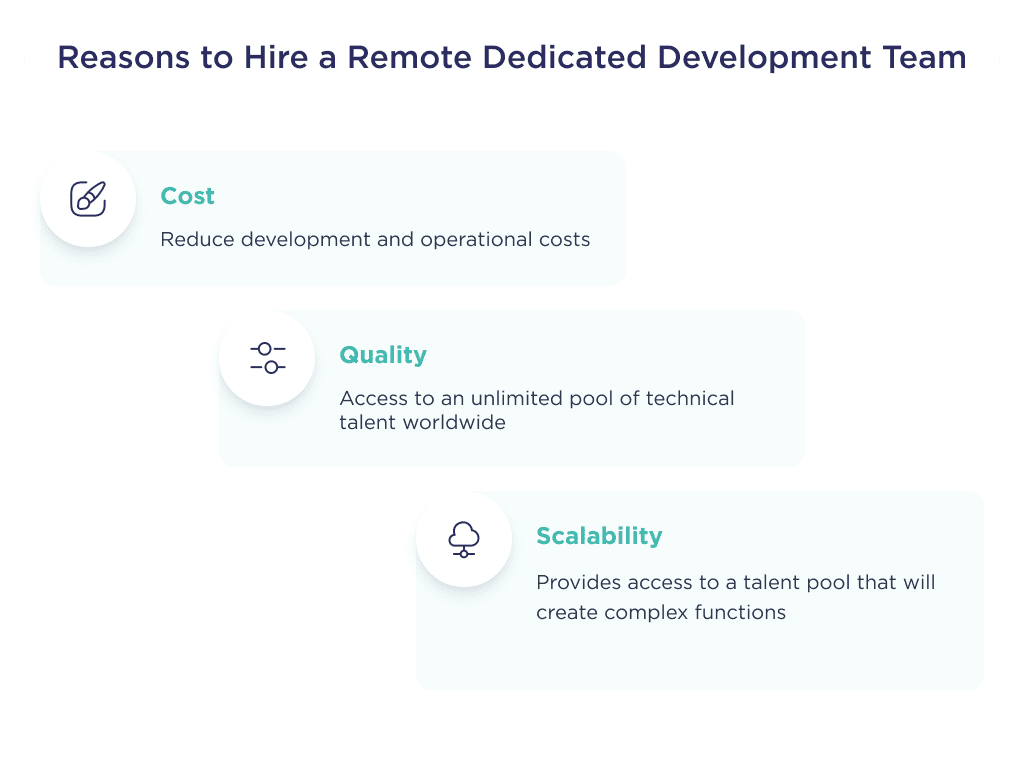
Now that you’re aware of some pros of this outsourcing model, let’s discuss some companies that are already excelling in it.
3 Well-Known Tech Companies that Hire Remote Teams
Below are some noteworthy companies that already outsource by hiring remote development teams. Let’s divulge those three companies:
Example 1. Google
As the report suggests, Google outsources most of its developmental processes to vendors to access talents they lack. In 2014, Google announced a remote outsourcing partnership with Globant – this partnership led to the development of project Ara.
Google currently outsources its development and maintenance to third-party vendors such as Infosys and Genpact.
Through offshore outsourcing, Google has been able to get needed talent and keep costs lower.
Example 2. GitHub
This open-source platform is loved for its intuitively designed application. GitHub, a platform with a community of over 23 million users, started by outsourcing its development to offshore teams.
In creating the platform, the company outsourced the backend of the platform to a remote development team.
The motive behind outsourcing is to get the backend done by the most talented individual at the lowest price possible. The current CIO, Scott Chacon, who’s also the company’s founder, felt that the outsource workers had a rare understanding of Gits.
Example 3. Slack
With more than 13 million daily users, Slack is the most popular communication channel for startups. It’s a messenger designed especially for workspaces: quick, easy to customize, and easy to integrate into the existing workflow.
However, the company hired a dedicated development team to help with most parts of the platform.
Slack outsourced its logo design, the website’s UX/UI design, and some parts and application.
The US-based company first outsourced its design to Butterfly before taking its prototype to MetaLab for development. 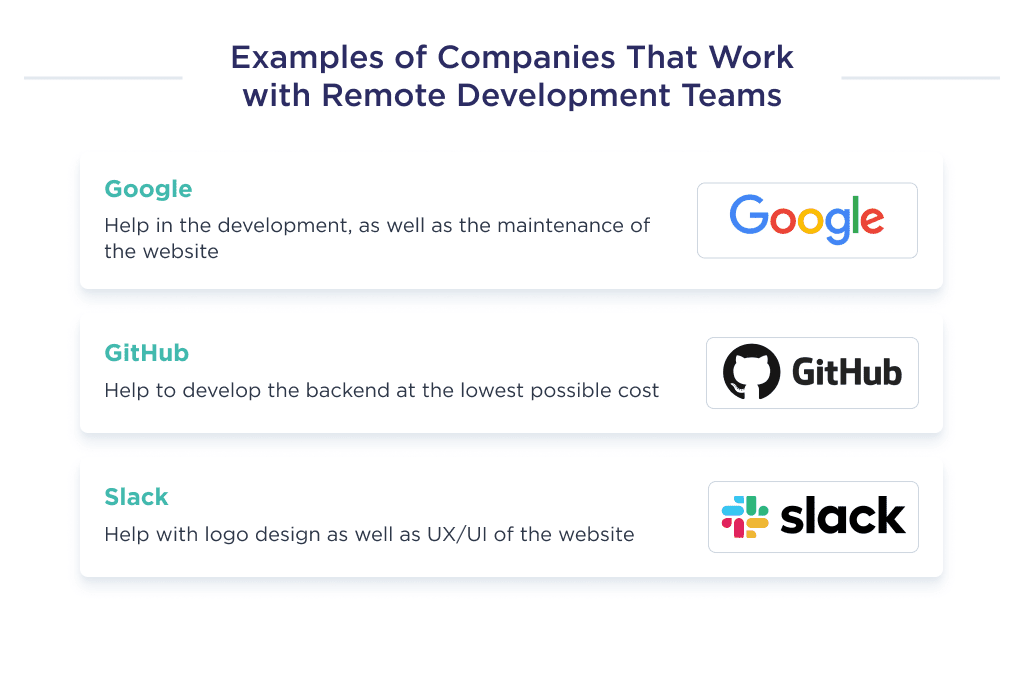
With the examples given above, I’m sure you’re considering onboarding a remote workforce with the skillset for your project. But before doing that, let’s educate you on your options.
Remote Development Team Collaboration Models
As a startup, you can set up your remote development team in a wide range of models–provided the chosen model fits your startup’s goal and helps to achieve an effective deliverable.
Here are the different types of ways to structure your outsourcing.
Model 1. Long-Term Dedicated Team
The most common outsourcing model is partnering with a workforce of remotely dedicated development teams intending to achieve a long-term objective.
This outsourcing model includes backend and front-end engineers, project managers, and other IT support professionals. So you can hire a dedicated web development team or hire dedicated mobile app developers.
This model is best for:
- Long term and well-funded projects that require dedication;
- Startups that require a sophisticated tech stack;
- Startups that lack the time and resources for the traditional hiring process.
Opt for this option if it aligns with your expectations.
Model 2. Temporary Team Extension
This model is straightforward. A startup approaches a vendor to hire developers to include in their in-house team. With this method, you can ensure that strategic competencies are within your supervision.
Here’s an example of this outsourcing model.
Assuming you’re developing a super app that inculcates payment, chatting, and mapping functionalities.
Since payment gateway development is quite complex, you can approach a vendor to get a back-end engineer proficient in FinTech technology stacks and requisite years of experience.
Explore the fintech trends that are revolutionizing the financial sector today.
The backend engineer joins your in-house workforce for a scheduled period. This helps you achieve your goal effectively while reducing ingestion and project management cost.
This outsourcing model gives you better control over your team. It also cancels out recruitment processes and eliminates the need for office space.
Model 3. Project-Based Hiring
This model of outsourcing is the direct opposite of hiring a dedicated team.
Here, a startup hires a dedicated team of developers for remote work to execute a single project for the company.
Let’s take a super-app for example. Since the app will include numerous stand-alone functionalities projects within a product, you can outsource one of them to the remote offshore team.
However, this outsourcing model requires top-notch synergy between in-house and outsourced teams. You need a seasoned project manager who can oversee the two groups and ensure timelines are kept.
This method of outsourcing is only ideal for startups that want:
- Short-term solution;
- Cost-effective deliverable.
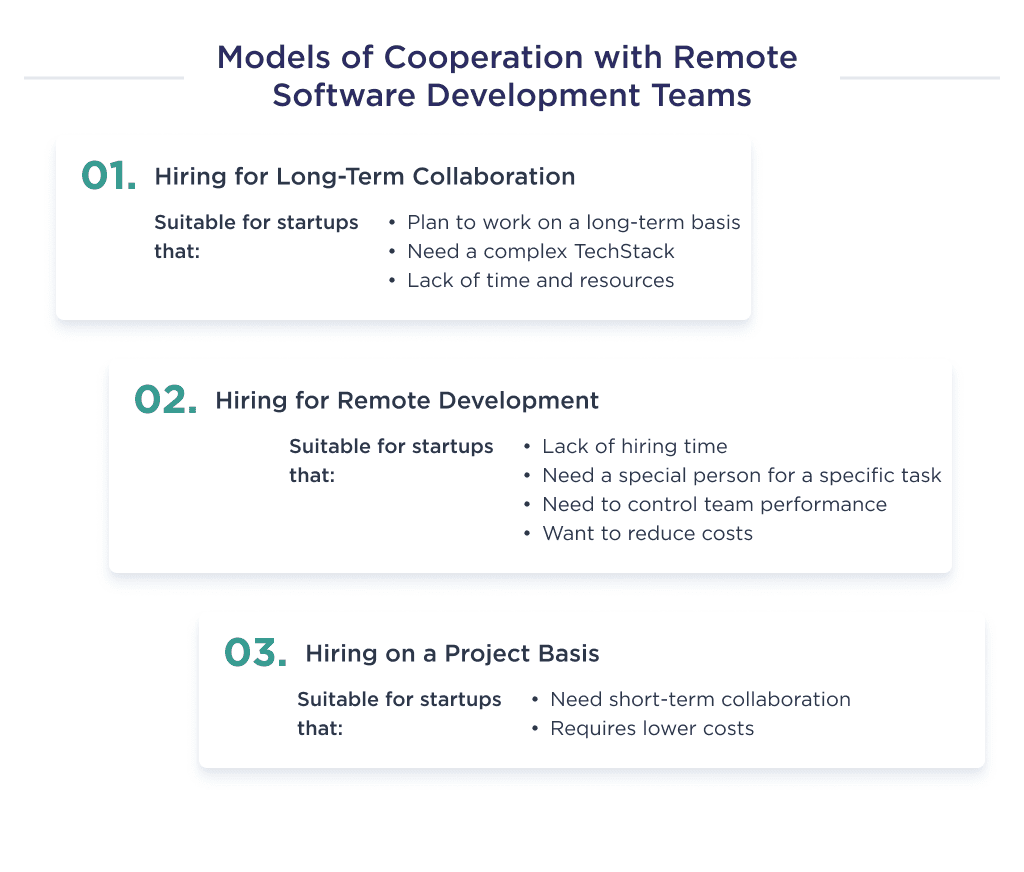
Need a reliable development team? Here’s your step-by-step guide to hiring a dedicated team in Ukraine.
Now that you’re knowledgeable about the different options available, let’s discuss them further.
How Much Does It Cost to Hire a Remote Software Development Team
The cost of hiring a remote team ranges from $6000 to $12,000 per month.
The exact cost of hiring depends on various factors, including the type of outsourcing model, the number of developers, their seniority, project technology, English level, and the like. By leveraging cutting-edge technologies, you can optimize candidate sourcing, screening, and scheduling interviews, saving time and improving the quality of your hires. Automating recruiting can revolutionize your talent acquisition strategy, so discover the power of this approach today.”
However, the primary determinant of cost is your remote team’s country. Generally, high-income countries are costlier than middle-income ones. As such, it’s a no-brainer that you’ll be required to pay more in the United States than in Ukraine.
For a rough calculation, let’s imagine that you develop a mobile app for 4 months with a team of 5 people.
Check the spreadsheet below for more information.
| Location | Average cost, $ |
| Australia | 110,000 |
| The USA | 180,000 |
| The UK | 130,000 |
| Western Europe | 100,000 |
| Eastern Europe or Ukraine | 60,000 |
| South Asia | 30,000 |
From the spreadsheet above, you’ll notice that the cost of hiring a U.S.-based developer is the priciest.
These are the best countries to outsource software development if you’re seeking top talent.
At the same time, Asia offers the best price for software development. However, software developed in Asia is often considered low quality. Thus, it’s best to opt for hire a dedicated development team from Ukraine.
Now that you know the cost implication of a remote team, what else? The next step is to begin recruiting. Let’s educate you on that.
How to Hire a Remote Development Team
To hire a remote team that can deliver on your project requirement, you should first understand your needs, search for vendors, and vet their talent pool.
Three steps to getting remote employees include:
- Sourcing for your developers offline or online;
- Ensuring your chosen developers know the requisite tech stacks and resources for the project blueprint;
- Verify their capacity.
Let’s discuss each point in detail.
Where to Find Remote Teams
Even with the knowledge of identifying good developers, you can’t embark on a developmental project if you can find a team.
You have the option of finding one online or offline. Although online searches are more convenient(and present the opportunity for hiring internationally), we’ll discuss the intricacies of both options in detail.
Here’s a spreadsheet of where to find a vendor for remote workers:
| Where to find | Details |
| Business listings | Business listings are directories that detail companies in a sector of business. As it pertains to your search, you can use Clutch. Streamline your search to specific locations for optimized results. |
| Search engine sites | Search engine sites have features that help you find companies. For example, Google searching for a “remote development team” will bring you a range of results. Also, search engine platforms have features that list companies. They’ll also pop up a lot of information about those organizations that can aid your vetting process. |
| Freelance platforms | Freelance platforms like Upwork, Toptal, Fiverr, etc., allow users to search for both freelancers and agencies. |
| Online meetups | Online meetups are virtual events set to discuss specific issues. Common examples of online meetups for tech include iForum and IT Arena. |
| Job boards | An example of a job board is LinkedIn. It is the world’s largest professional network on the Internet. By signing up to the platform as a recruiter, you can easily navigate to find a suitable remote software development company. |
| Your network | This is perhaps one of the most trusted means of recruiting. If you’re a seasoned tech entrepreneur or you have a network of tech experts, then ask your colleagues. More than 30% of new hires are done through referrals. |
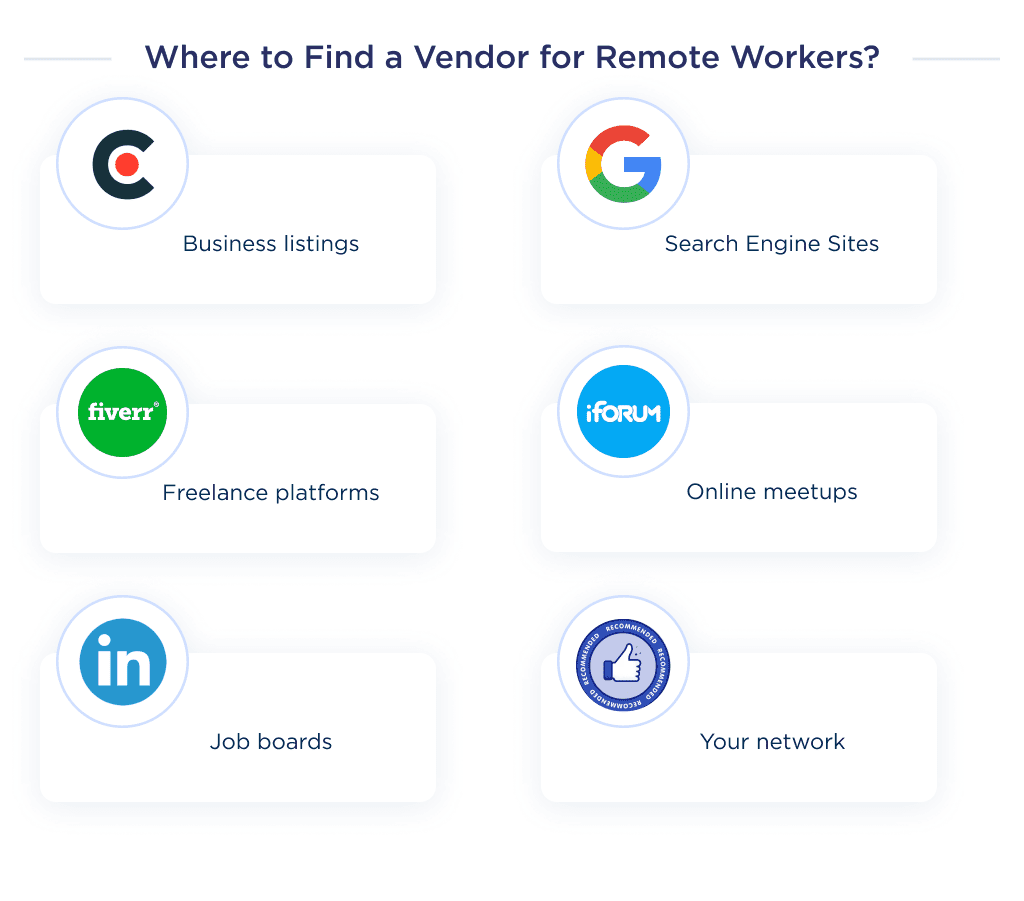
Choosing the Best Team
Once you’ve created a list of teams that appeals to your startup, it’s time to research deeper.
Investigate their website and portfolio, check reviews on Clutch, LinkedIn, and search engine sites, and ensure they have requisite communication skills.
Below is a breakdown of how to make the right choice.
Step 1. Define What you Expect
What are your expected deliverables? Don’t just think about the website or app you want to create. Think about your business goals and the strategies to achieve them.
Do you want to create a bare-bone MVP or a fully scaled product?
Once you’ve identified the type of product you want, then next is to choose an ideal team for actualizing your goals.
Do you want a team of experts, quick learners, or doers? Ideally, the most effective teams have a perfect balance of the three.
The expert provides the experience of how best to create a product: the quick learners introduce new tech stacks that can make development productive, while the doer ensures timely project completion.
Find the best TypeScript developers for your project.
Step 2. Negotiate
Negotiation is non-debatable when considering a team of programmers to hire. Why? The crux of having a successful development process lies in your ability to communicate expected deliverables.
The founder should first estimate the resources needed for project completion before starting the negotiation process. This estimate will help guide the negotiation process.
For non-technical founders, it’s best to hire a CTO to help meander some technical requirements.
Since negotiation will be mostly virtual, both sides must agree on the communication model, channels, and times.
And before you start, schedule a discussion to ensure they understand the project, its goals, and the requirements you’ll need to achieve given milestones. You should also hassle out the price.
Excellent communication helps the outsourced team to align with your in-house developers.
Step 3. Shortlist
Before settling for an option, investigate their capacity to deliver according to the project blueprint and set milestones.
Try to widen your investigation to their software engineers (if the information is available). Ensure they have the soft skills to make your partnership successful.
Check the company’s review on reputable platforms like Clutch and Good Firms.
Research the following points and check if it aligns with your company’s expectation:
- Location. Opt for a remote team whose time zone aligns with your work hours. And if not, ask if they’re willing to make needed sacrifices by working off-work hours.
- Hourly rate. Since your developers work remotely, their charges should be much lesser than an in-house team.
- Reviews. They should have verifiable reviews on reputable platforms.
- Level of expertise. The entire team should exhibit the top-notch expertise you need to deliver your project.
- Project portfolio. Check through their mobile app development and web development portfolio. This would give you a hint on their project’s quality.
- General info. Read up on the company’s general info on their website.
A trick to easily identify a vendor that prioritizes user experience is growth.
Good service providers always experience noteworthy growth. As such, an increase in staff strength is evidence of rapid growth.
With regards to growth, an average Ukrainian outsourcing agency has grown 2.5 times larger in the last five years.
Step 4. Finalize Agreements and Sign Requisite Document
Before the developmental process commences, you should protect your idea.
The first important step to take is to sign a non-disclosure agreement with the vendor. After this, both parties should sign a transparent contract that’ll detail each party’s expected workflow and deliverables.
The contract should also spell out project milestones, objectives, and the contract’s lifespan.
Once you’ve signed all the necessary documents, you’re good to start. However, managing a remote team of developers can be challenging. 
As such, let’s discuss how to manage your software workforce appropriately.
Managing a Remote Software Team
Managing a remote software workforce entails using a strategy, such as Agile methodology and remote team management software, to oversee your team’s activities and align their daily tasks and workflows to complement your startup’s developmental goal.
The pandemic caused the demand for remote work to increase. However, many startups are struggling with this communication model due to poor management skills.
Use these tips to ensure your remote workforce remains as effective as possible:
1. Work Across Time Zones
Time zone difference is a major impediment to remote team management. One possible solution to this is using “golden hours.” Golden hours are specific times of the day when your work hours and that of your remote team collide.
You can use TimeAndDate and EveryTimeZone to calculate time zone differences and intersections.
2. Use Tracking Tools
Use tracking tools to understand what’s going on in your project, how long each developer has worked, and what they’re currently doing.
Some time-tracking tools to try include:
- Jira
- Asana
- Clockify
According to tempo.io, not actively tracking freelancers’ time reduces productivity by up to 45%. So it’s best to take this seriously. 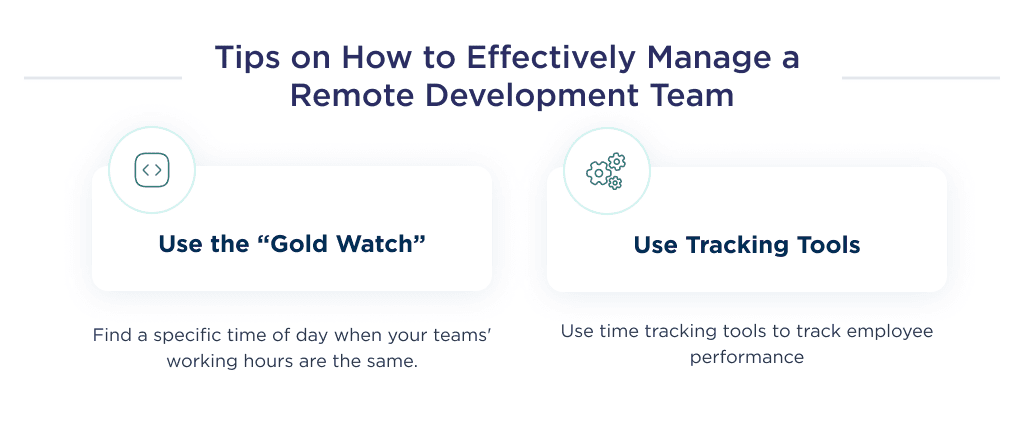
The next important point to consider is the challenges of hiring a remote development team. Let’s dig into that.
Challenges of Remote Teams
Understanding remote software development challenges can help you avoid impediments that can prevent your planned completion. Here are the critical barriers to be wary of:
1. Completing Projects
This particular challenge applies to a remote workforce made up of freelancers. Freelancers are hardly committed to any startup or project, and their loyalty can easily shift when they receive an offer with more promising pay.
To mitigate against this challenge, startups should only partner with remote development teams with a full-time workforce. Startups should also ensure the contract agreement enforces compulsory project completion.
2. Legal Risks
Paperworks are essential to keep your idea backed by law. What do we mean?
You should sign contractual agreements detailing the expected workflow, engagement model, and project milestones and goals.
It’s imperative also to sign a non-disclosure agreement. Doing this keeps sensitive details about your project secret from competitors.
Access premium design and development services for unmatched success.
3. Security Issues
Communication with your remote team happens in a decentralized environment. This makes sensitive information like passwords, financial data, and proprietary information susceptible to hacks over wireless networks.
In some instances, hackers also target customers’ sensitive personal information, and since most remote team members will have such information, it gives hackers multiple potential access points.
To reduce security risks, request your workforce to use 2FA across all platforms, and ensure they are using VPN for data encryption.
This will greatly reduce the risk of unauthorized access and protect your company’s valuable information. 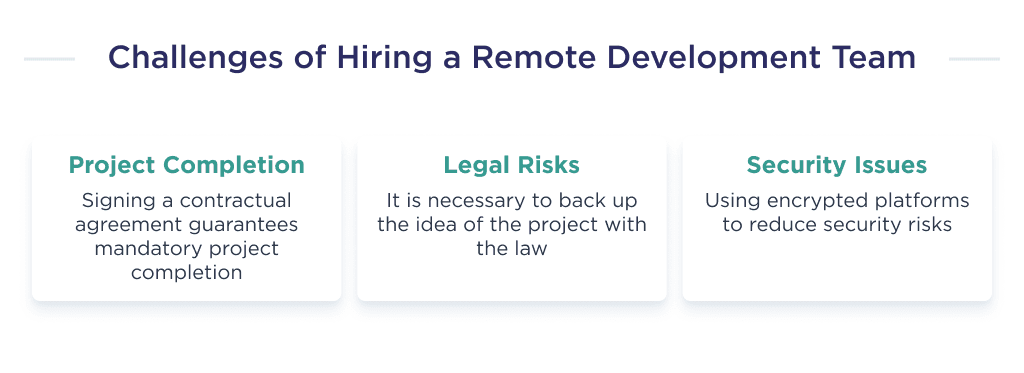
With the details above on hiring a remote team, I’m pretty sure you’re considering one. Keep reading to know how we can make your development worthwhile.
Ready to Hire a Remote Team?
Getting expertise is key to creating user-friendly solutions. Startups can choose between in-house or remote teams.
Contact us today if you’re looking for an experienced remote team to bring your vision to life. We’ll discuss your needs and how our developers can help take your product to the next level.
Don’t wait – get in touch now to leverage our team’s skills on your project!
Need a CTO but not ready for a full-time hire? Here’s how to hire a CTO on demand and get the expertise you need.
Bonus Infographic
Here is a summary of our detailed guide. Learn the step-by-step process of hiring a remote dedicated development team. 



